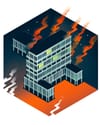What would become of the Civic Offices on Wood Quay if the council relocates?
After The Currency reported the idea of the council moving its HQ, councillors were talking about and thinking through the pros and cons and implications.
This is an isometric projection of one of my favourite Dublin buildings – Fitzwilton House, designed by Emanuel Shoolheifer and Don Burley and completed in 1969. Fitzwilton House is due to be demolished, as are several other Dublin buildings from around this time – including the much-hated Hawkins H

This is an isometric projection of one of my favourite Dublin buildings – Fitzwilton House, designed by Emanuel Shoolheifer and Don Burley and completed in 1969.
Fitzwilton House is due to be demolished, as are several other Dublin buildings from around this time – including the much-hated Hawkins House and the (unjustly) equally loathed Apollo House. Dublin is architecturally poor enough without this period of design being erased.
Despite first appearances perhaps, Fitzwilton House is highly expressive and visually exciting building. Several tones of concrete are used on its narrow vertical exterior columns, in the upper block these columns form an even, steady rhythm, but in the lower sections the pattern becomes irregular. It sits diagonally to the canal, meaning you approach it from interesting angles; make sure to give it a look while you still can.